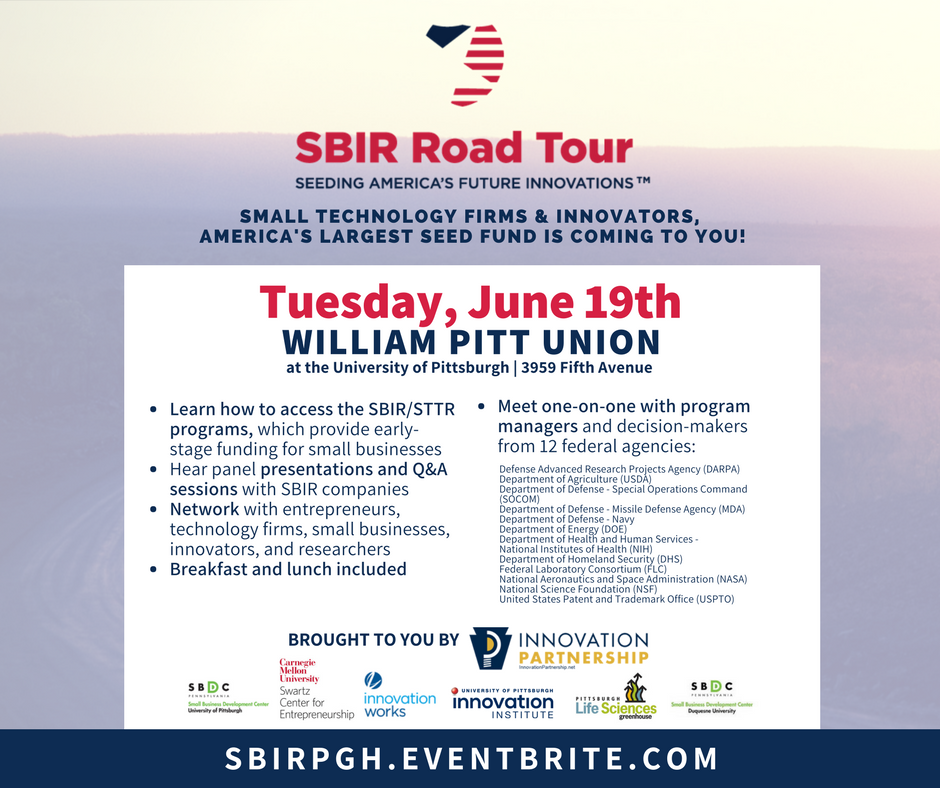Next month, the SBIR Road Tour will be making a stop in Pittsburgh for a day-long event to promote the $2.5 billion in funding available from a dozen federal government agencies to help small businesses bring innovative new products and technologies to market.
In this post, the Innovation Institute’s resident SBIR expert Paul Petrovich explains why an SBIR or STTR grant application could be right for your company.

A remnant of the waning Cold War era, when the Congress and President Ronald Reagan decided that the U.S. needed to heat up small business innovation, remains a compelling funding source to bring new products to market.
President Reagan signed into law the Small Business Innovation Development Act of 1982 to provide funding for some of the best early-stage ideas housed in America’s small businesses. The Small Business Innovation Research (SBIR) program enabling legislation was driven by the initial success of a pilot National Science Foundation (NSF) program. The NSF was the first of now 11 federal agencies that provide funding through the SBIR program, which many people consider one of the most significant government programs of the 20th century in the field of science and technology.
When reauthorized in 1992, a sister program, the Small Business Technology Transfer or STTR program, was also established. Following the same principles of the SBIR program, STTR is designed to cultivate technology transfer between small business and universities and other federally supported research institutions.
Both programs follow the same selection process. Following submission of proposals to one of the eleven participating agencies, awards are made based on the degree of innovation, technical merit, agency interest, quality of the principal investigator, and future market potential. Small businesses that receive awards then begin a three-phase process within the program.
Phase I is the concept phase. Up to $150,000 is awarded to prove the technical feasibility of an idea or technology over a six-to-nine-month period.
Phase II is the R&D phase. Up to $1 million is available for up to two years to further expand upon and develop the Phase I results. A competitive Phase II proposal submission from the small business is required.
Phase III is the commercialization phase. No SBIR funds support this phase. The small business must find private funding or secure it from other non-SBIR federal sources.
The SBIR/STTR program provides product development funding for high risk technical development that typically isn’t available anywhere else. The program requires no repayment and no ownership is exchanged. Three essential reasons to use the federal SBIR/STTR programs as a source of product development funding are:
# 1. OVER $2.5 BILLION OF NON-DILUTIVE FUNDING IS AVAILABLE EACH YEAR
Since its inception, more than $30 billion has been awarded to U.S. small businesses.
The SBIR and STTR Programs are affiliated with 11 federal agencies, each with an extramural research and development budget of $100 million or more, who collectively set aside $2.5 billion annually to support the development of cutting-edge technological ideas into marketable products.
#2. A SBIR/STTR AWARD HELPS ESTABLISH CREDIBILITY
Potential investors are well aware of the rigorous review process of the SBIR/STTR program (Phase I success rates are typically in the 10-15% range) and understand the team commitment and expertise required to succeed in this program, including a detailed application requirement. As such, success within the SBIR/STTR program provides needed credibility, especially as teams progress to Phase II and further reduce the technology’s risk, address market risk, and demonstrate your ability to execute as a viable business.
Keep in mind that the SBIR/STTR program provides product feasibility and development funding. The funding’s primary focus is not to support production, manufacturing, marketing, legal, and other related business development costs (although you are able to take a 7% fee as part of your grant budget that is not restricted and you may apply to these purposes). You will need additional funding. Your achievement of winning and your success within the SBIR/STTR program will help position your company to secure additional funding to fully develop and scale your opportunity for the market.
#3. THE SMALL BUSINESS OWNS THE INTELLECTUAL PROPERTY IT DEVELOPS
An SBIR/STTR award allows the small business to retain all of the intellectual property (patents, copyrights, trade secrets, trademarks, or data) developed using the funding from the federal agency.
This doesn’t occur automatically. Small businesses need to be proactive and protect their discoveries with the assistance of legal counsel. Intellectual property protection is important not only to the small business, but also to the agency reviewers and the investors that are approached for follow-on funding.
A key focus for businesses engaged in a Phase I SBIR/STTR grant is positioning for follow-on investment. In the Phase II proposal the small business will fully describe its funding strategy in a full-blown business plan that demonstrates a deep understanding of the market, customers, competition, financing, and intellectual property status.
Interested in learning more? The SBIR Road Tour is coming to Pittsburgh on Tuesday, June 19. Attendees will learn how to access local and state resources available to innovators, researchers, and technology entrepreneurs. Individual program managers from the 11 participating federal agencies will participate in this one-day event alongside technology entrepreneurs and state economic development officials.
To sign up for the Pittsburgh SBIR Road Tour, register today at: www.sbirpgh.eventbrite.com.
If you are a Pitt Innovator unable to attend but interested in learning more about the SBIR/STTR program, contact Paul Petrovich from the Innovation Institute for assistance at: ppetrovich@innovation.pitt.edu.